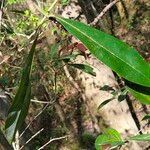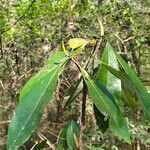Shrub to 5 m; lvs elliptic to commonly oblanceolate, to 15 cm, acute or short-acuminate, entire, narrowed to the base, glabrous or nearly so at maturity; fls sessile in lateral clusters on old wood, usually precocious; cor yellow, the lobes 7–9 mm; stamens in 5 clusters alternating with the cor-lobes, each cluster with 6–10 filaments united at base and about as long as the cor; fr slenderly ellipsoid, dry, 6–10 mm. Woods, chiefly on the coastal plain; Del. to Fla. and La., n. in the Miss. valley to Ark. and Tenn. Apr., May.
A tree.


